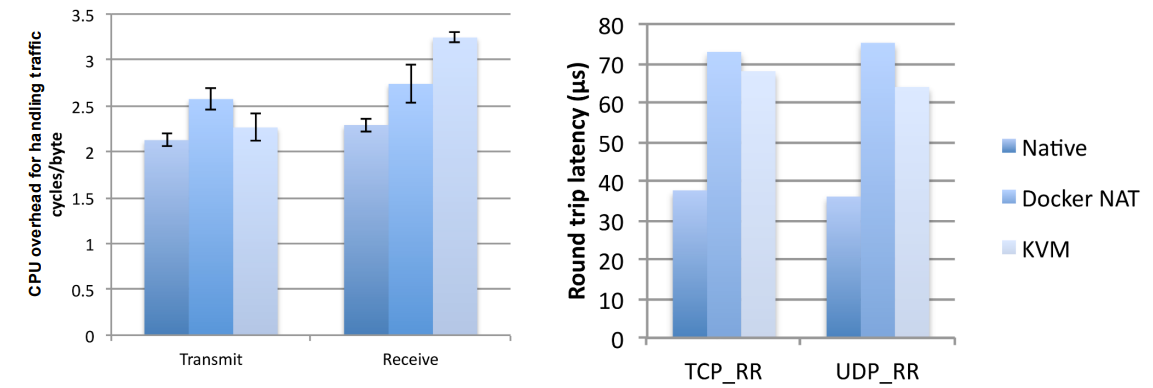Virtual Machines (VMs) and containers are both virtualization technologies that enable software to run in isolated environments, but they differ significantly in their architecture, resource usage, performance characteristics, and use cases.
Architectural Differences
Virtual Machines
- Level of Virtualization: Hardware-level virtualization
- Components:
- Hypervisor (VMM) running on physical hardware
- Complete guest OS for each VM
- Virtualized hardware for each VM
- Applications running on the guest OS
- Isolation: Strong isolation at the hardware level
- Resource Allocation: Dedicated virtual hardware resources
Containers
- Level of Virtualization: OS-level virtualization
- Components:
- Host OS running on physical hardware
- Container runtime (e.g., Docker)
- Application and its dependencies
- Shared OS kernel
- Isolation: Process-level isolation using OS features (namespaces, cgroups)
- Resource Allocation: Shared OS kernel, isolated user space
Performance Comparison
Based on benchmarking studies, containers and VMs show different performance characteristics across several dimensions:
CPU Performance

- Both VMs and containers show minimal overhead for CPU-intensive workloads (1-5%)
- VMs may have slightly higher overhead due to virtualization layer
Memory Access
- Containers: Near-native memory access performance
- VMs: Similar random access performance but slightly lower sequential access bandwidth
- Memory management overhead is higher in VMs due to virtualized memory management units and shadow page tables
Network Performance

- Containers: Lower latency and higher throughput than VMs
- VMs: Additional overhead due to virtual network devices
- Docker NAT can increase latency for containers
Disk I/O


- Containers: Better I/O performance than VMs, especially for random I/O
- VMs: Higher latency due to virtual I/O devices
- Both have similar throughput for sequential operations
Boot Time
- Containers: Start in seconds (typically 1-5 seconds)
- VMs: Start in minutes (typically 30-60 seconds)
Resource Overhead
- Containers: Minimal overhead (MBs)
- VMs: Significant overhead (GBs for each VM)
Image Size & Startup Time
Image Size
- VM Images:
- Typically gigabytes in size (e.g., 5-20GB)
- Contain entire operating system
- Include all libraries and binaries
- Container Images:
- Typically megabytes in size (e.g., 10-300MB)
- Only include application and dependencies
- Share the host OS kernel
Startup Time
- VM Startup:
- Operating system boot process
- Initialization of all OS services
- Typically takes 30+ seconds
- Container Startup:
- No OS boot required
- Application process start only
- Typically takes milliseconds to seconds
Isolation & Security
Virtual Machines
- Stronger Isolation: Complete separation at hardware level
- Security Benefits:
- Hardware-enforced boundaries
- Separate kernel instances
- Vulnerabilities in one VM don’t affect others
- Hypervisor provides additional security layer
- Attack Surface:
- Smaller attack surface (hypervisor code is much smaller than OS kernel)
- VM escape vulnerabilities are rare
Containers
- Weaker Isolation: Process-level isolation within same OS
- Security Concerns:
- Shared kernel between containers
- Container escape risks
- Root privileges in container could potentially affect host
- Mitigation Techniques:
- User namespaces
- Seccomp profiles
- AppArmor/SELinux policies
- Non-root users in containers
- Read-only filesystems
Use Cases
Virtual Machines Excel For
- Running Different Operating Systems: e.g., Windows on Linux host
- Strong Security Requirements: Regulatory compliance, multi-tenant environments
- Traditional Monolithic Applications: Legacy applications
- Kernel-Level Customization: Custom kernel modules or settings
- Hardware-Level Features: Direct access to specialized hardware
Containers Excel For
- Microservices Architecture: Multiple small, independent services
- DevOps Workflows: CI/CD pipelines, rapid deployment
- Application Packaging: Consistent environments from dev to production
- High-Density Applications: Maximizing resource utilization
- Stateless Applications: Web servers, API endpoints
- Short-Lived Processes: Batch jobs, serverless workloads
Managing Both Technologies
VM Management
- Hypervisors: VMware ESXi, KVM, Hyper-V, Xen
- Cloud Platforms: AWS EC2, Azure VMs, Google Compute Engine
- Operations: VM migration, snapshots, templates
Container Management
- Container Runtimes: Docker, containerd, CRI-O
- Orchestration: Kubernetes, Docker Swarm, Amazon ECS
- Operations: Container lifecycle, image management, networking
Comparison Table
| Feature | Virtual Machines | Containers |
|---|---|---|
| Virtualization Level | Hardware | Operating System |
| Size | Gigabytes | Megabytes |
| Boot Time | Minutes | Seconds |
| Performance Overhead | Higher | Lower |
| Isolation | Strong | Moderate |
| Resource Efficiency | Lower | Higher |
| OS Diversity | Any OS supported by hardware | Same OS kernel as host |
| Security | Strong isolation | Process-level isolation |
| Portability | Less portable (hypervisor-specific) | Highly portable |
| Density | Dozens per host | Hundreds or thousands per host |
| Persistent Data | Built-in storage | Requires volumes |
| Maturity | Very mature | Rapidly maturing |
Hybrid Approaches
VM-based Containers
- Container hosts running inside VMs
- Benefits of both technologies
- Common in cloud environments
- Example: Kubernetes clusters on VMs in the cloud
Kata Containers
- Containers running in lightweight VMs
- Container interface with VM isolation
- Compatible with container ecosystems
Firecracker
- Lightweight VMM for serverless containers
- Combines VM security with container startup time
- Used in AWS Lambda and Fargate
Making the Right Choice
Consider these factors when choosing between VMs and containers:
- Security Requirements: Level of isolation needed
- Performance Needs: Resource overhead considerations
- Application Architecture: Monolithic vs. microservices
- Operational Complexity: Team expertise and tooling
- Portability Requirements: Cross-platform needs
- Resource Constraints: Available hardware resources
- Development Workflow: Integration with CI/CD